AP State Syllabus AP Board 9th Class Maths Solutions Chapter 2 Polynomials and Factorisation Ex 2.4 Textbook Questions and Answers.
AP State Syllabus 9th Class Maths Solutions 2nd Lesson Polynomials and Factorisation Exercise 2.4
Question 1.
Determine which of the following polynomials has (x + 1) as a factor.
i) x3 – x2 – x + 1
Solution:
f(- 1) = (- 1)3 – (- 1)2 – (- 1) + 1
= -1 – 1 + 1 + 1 = 0
∴ (x + 1) is a factor.
![]()
ii) x4 -x3 +x2 – x + 1
Solution:
f(- 1) = (- 1)4 – (- 1)3 + (- 1)2 – (- 1) + 1
= 1 + 1 + 1 + 1 + 1= 5
∴ (x + 1) is not a factor.
iii) x4 + 2x3 + 2x2 + x + 1
Solution:
f(- 1) = (-1)4 + 2 (- 1)3 + 2 (- 1)2 + (-1) + 1
= 1 – 2 + 2 – 1 + 1 = 1
∴ (x + 1) is not a factor.
iv) x3 – x2 – (3 – √3)x + √3
Solution:
f(- 1) = (- 1)3 – (- 1)2 – (3 – √3)(-1) + √3
= – 1 – 1 + 3 – √3 + √3 = 1
∴ (x + 1) is not a factor.
Question 2.
Use the factor theorem to determine whether g(x) is a factor of f(x) in each of the following cases:
i) f(x) = 5x3 + x2 – 5x – 1; g(x) = x + 1
[Factor theorem : If f(x) is a polynomial; f(a) = 0 then (x – a) is a factor of f(x); a ∈ R]
Solution:
g(x) = x+ 1 = x- a say
∴ a = – 1
f(a) = f(- 1) = 5 (- 1)3 + (- 1)2 – 5 (- 1) – 1
= -5 + 1 + 5 – 1 = 0
∴ x + 1 is a factor of f(x).
![]()
ii) f(x) = x3 + 3x2 + 3x + 1; g(x) = x + 1
Solution:
g(x) = x + 1 = x – a
∴ a = – 1
f(a) = f(- 1) = (- 1)3 + 3 (- 1)2 + 3(-1) + 1
= -1 + 3 – 3 + 1 =0
∴ f(x) is a factor of g(x).
iii) f(x) = x3 – 4x2 + x + 6;
g(x) = x – 2
Solution:
g(x) = x- 2 = x- a
∴ a = 2
f(a) = f(2) = 23 – 4(2)2 + 2 + 6
= 8 – 16 + 2 + 6 = 0
∴ g(x) is a factor of f(x).
![]()
iv) f(x) = 3x3+ x2 – 20x +12; g(x) = 3x – 2
Solution:
g(x) = 3x – 2 = \(x-\frac{2}{3}\) = x – a
∴ a = 2/3
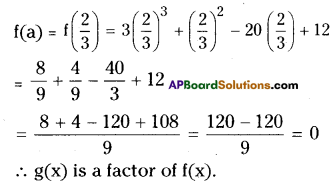
v) f(x) = 4x3+ 20x2+ 33x + 18; g(x) = 2x + 3
Solution:
g(x) = 2x + 3 = x + \(\frac{3}{2}=\) = x – a
∴ a = -3/2
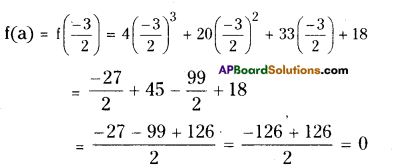
∴ g(x) is a factor of f(x).
![]()
Question 3.
Show that (x – 2), (x + 3) and (x – 4) are factors of x3 – 3x2 – 10x + 24.
Solution:
Given f(x) = x3 – 3x2 – 10x + 24
To check whether (x – 2), (x + 3) and (x – 4) are factors of f(x), let f(2), f(- 3) and f(4)
f(2) = 23 – 3(2)2 – 10(2) + 24
= 8- 12-20 + 24 = 0
∴ (x – 2) is a factor of f(x).
f(- 3) = (- 3)3 – 3(- 3)2– 10(- 3) + 24
= – 27 – 27 + 30 + 24 = 0
∴ (x + 3) is a factor of f(x).
f(4) = (4)3 – 3 (4)2 – 10 (4) + 24
= 64 – 48 – 40 + 24
= 88 – 88
= 0
∴ (x – 4) is a factor of f(x).
Question 4.
Show that (x + 4), (x – 3) and (x – 7) are factors of x3 – 6x2 – 19x + 84.
Solution:
Let f(x) = x3 – 6x2 – 19x + 84
To verify whether (x + 4), (x – 3) and (x – 7) are factors of f(x) we use factor theorem.
Let f(- 4), f(3) and f(7)
f(- 4) = (- 4)3 – 6 (- 4)2 – 19 (- 4) + 84
= -64 – 96 + 76 + 84
= 0 .
∴ (x + 4) is a factor of f(x).
f(3) = 33 – 6(3)2 – 19(3) + 84
= 27 – 54 – 57 + 84
= 0
∴ (x – 3) is a factor of f(x).
![]()
f(7) = 73 – 6(7)2 – 19(7) + 84
= 343 – 294 – 133 + 84
= 427 – 427
= 0
∴ (x – 7) is a factor of f(x).
Question 5.
If both (x – 2) and \(\left(x-\frac{1}{2}\right)\) of px2 + 5x + r, show that p = r.
Solution:
Let f(x) = px2+ 5x + r
As (x – 2) and \(\left(x-\frac{1}{2}\right)\) are factor of f(x), we have f(2) = 0 and f(1/2) = 0
∴ f(2) = p(2)2 + 5(2) + r
= 4p + 10 + r = 0
= 4p + r
= – 10 ………………(1)

⇒ p + 10 + 4r = 0
⇒ p + 4r = – 10 ………………. (2)
From (1) and (2);
4p + r = p + 4r
4p – p = 4r – r
3p = 3r
∴ P = r
![]()
Question 6.
If (x2 – 1) is a factor of ax4 + bx3 + cx2 + dx + e, show that a + c + e = b + d = 0.
Solution:
Let f(x) = ax4 + bx3 + cx2 + dx + e
As (x – 1) is a factor of f(x) we have
x2 – 1 = (x + 1) (x – 1) hence f(1) = 0 and f(-1) = 0
f(1) = a + b + c + d + e = 0 ……………. (1)
and f(-1) = a- b + c- d + e = 0
⇒ a + c + e = b + d
Substitute this value in equation (1)
a + c + e + b + d=0
b + d + b + d=0
2 (b + d) = 0
⇒ b + d = 0
∴ a + c + e = b + d = 0
![]()
Question 7.
Factorise
i) x3 – 2x2 – x + 2
Solution:
Let f(x) = x3 – 2x2 – x + 2
By trial, we find f(l) = 13 – 2(1)2 – 1 + 2
= 1 – 2 – 1 + 2
= 0 .
∴ (x – 1) is a factor of f(x).
[by factor theorem]
Now dividing f(x) by (x – 1).
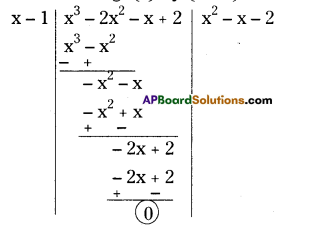
f(x) = (x – 1) (x2 – x – 2)
= (x – 1) [x2 – 2x + x- 2]
= (x – 1) [x (x – 2) + 1 (x – 2)]
= (x – 1) (x – 2) (x + 1)
ii) x3 – 3x2 – 9x – 5
Solution:
Let f(x) = x3 – 3x2 – 9x – 5By trial,
f(- 1) = (- 1)3 – 3(- 1)2 – 9(- 1) – 5
=-1 – 3 + 9 – 5
=0
∴ (x + 1) is a factor of f(x).
[ ∵ by factor theorem]
Now dividing f(x) by (x + 1).

f(x)=(x + 1)(x2 – 4x – 5)
But x2– 4x – 5 = x2 – 5x + x – 5
= x (x – 5) + 1 (x – 5)
=(x – 5)(x + 1)
∴ f(x)=(x + 1)(x + 1)(x – 5)
![]()
iii) x3 + 13x2 + 32x + 20
Solution:
Let f(x) = x3 + 13x2 + 32x + 20
Let f(- 1)
= (- 1)3 + 13 (- 1)2 + 32 (- 1) + 20
= – 1 + 13 – 32 + 20 = 33 – 33 = 0
∴ (x + 1) is a factor of f(x).
[ ∵ by factor theorem] Now dividing f(x) by (x + 1).

iv) y3 + y2 – y – 1
Let f(y) = y3 + y2 – y – 1
f(1) = 13+ 12– 1 – 1 = 0
(y – 1) is a factor of f(y).
Now dividing f(y) by (y – 1).
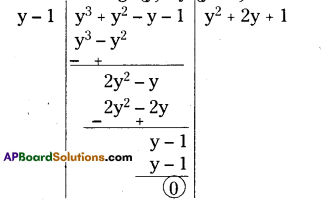
∴ f(x) = (x + 1)(x2 + 12x + 20)
But (x2 + 12x + 20) = x2+ 10x + 2x + 20
=x(x + 10)+2(x + 10)
=(x + 10)(x + 2)
∴f(x) = (x + 1)(x + 2)(x + 10)
![]()
Question 8.
If ax2 + bx + c and bx2 + ax + c have a common factor x + 1 then show that c = 0 and a = b.
Solution:
Let f(x) = ax2 + bx + c and g(x) = bx2 + ax + c given that (x + 1) is a common factor for both f(x) and g(x).
∴ f(-1) = g(- 1)
⇒a(- 1)2 + b(- 1) + c
= b(- 1)2 + a (- 1) + c
⇒ a – b + c = b – a + c
⇒ a + a = b + b
⇒ 2a = 2b
⇒ a = b
Also f(- 1) = a – b + c = 0
⇒ b – b + c = 0
⇒ c = 0
Question 9.
If x2 – x – 6 and x2 + 3x – 18 have a common factor x – a then find the value of a.
Solution:
Let f(x) = x2 – x – 6 and
g(x) = x2 + 3x – 18
Given that (x – a) is a factor of both f(x) and g(x).
f(a) = g(a) = 0
⇒ a2 – a – 6 = a2 + 3a – 18
⇒ – 4a = – 18 + 6
⇒ – 4a = – 12
∴ a = 3
![]()
Question 10.
If (y – 3) is a factor of y3– 2y2– 9y + 18, then find the other two factors.
Solution:
Let f(y) = y3– 2y2 – 9y + 18
Given that (y – 3) is a factor of f(y).
Dividing f(y) by (y – 3)
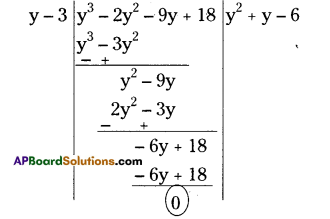
∴ f(y) = (y – 3) (y + y – 6)
But y2 + y – 6
= y2 + 3y – 2y – 6
= y (y + 3) – 2 (y + 3)
= (y + 3) (y – 2)
∴ f(y) = (y – 2)(y – 3)(y + 3)
The other two factors are (y – 2) and (y + 3).